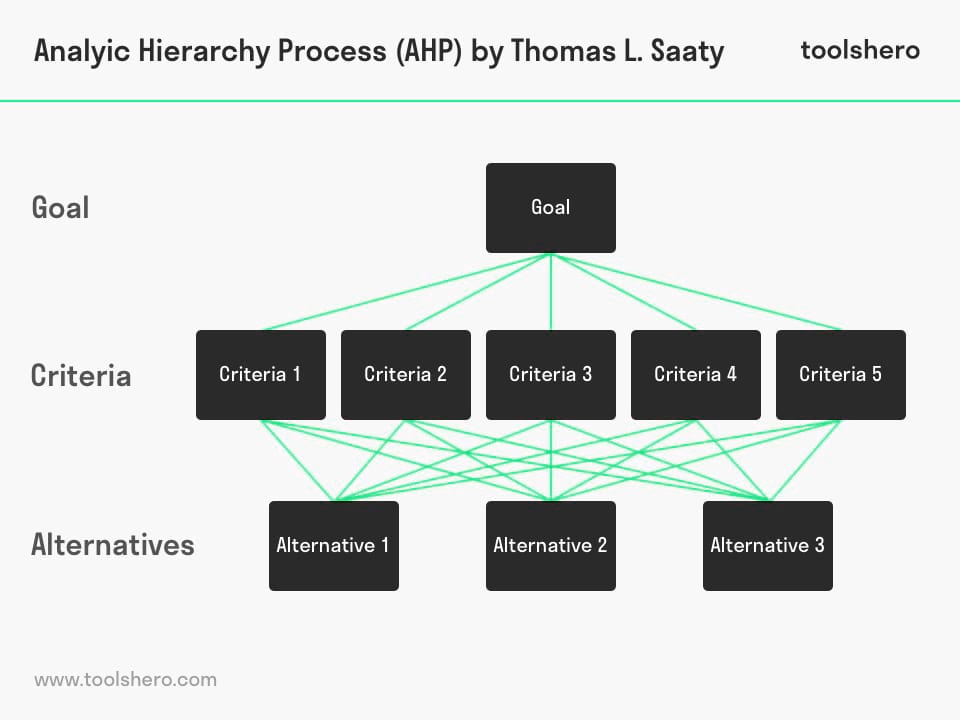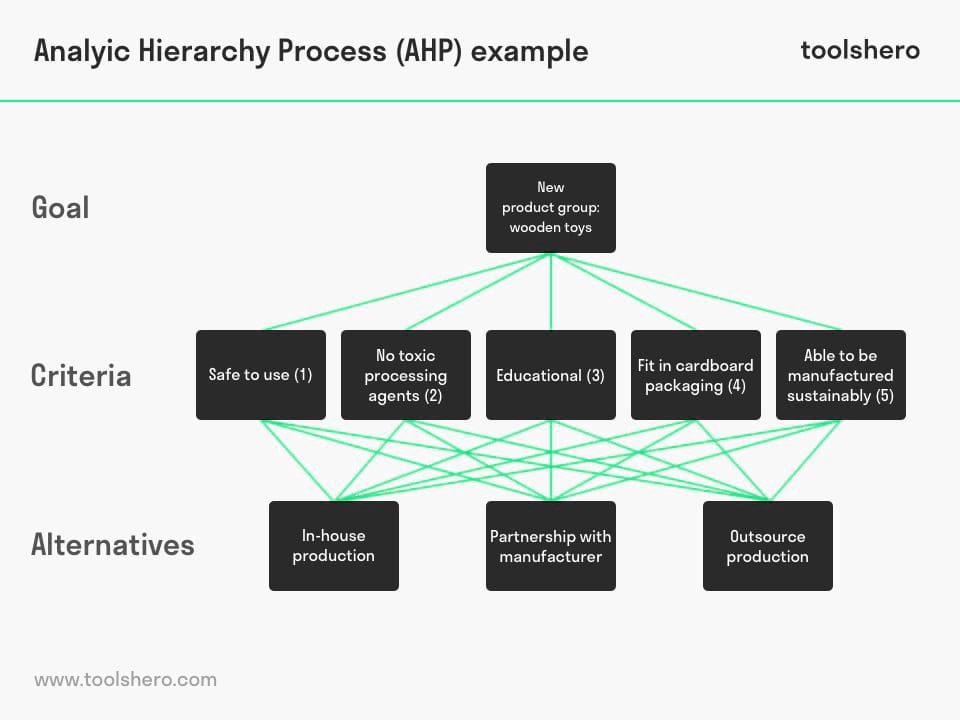Analytic Hierarchy Process (AHP)

Analytic Hierarchy Process (AHP): this article describes the Analytic Hierarchy Process (AHP) by Thomas L. Saaty in a practical way. It cover what the AHP is, why and when it is useful, how to apply it and what it looks like in an example. After reading this article, you will understand the basics of this decision making tool. Enjoy reading!
What is the Analytic Hierarchy Process (AHP)?
It is not always easy for individuals and organisations to choose and make decisions. In the 1970s, American management professor Thomas L. Saaty developed a model that can help when making decisions.
The Analytic Hierarchy Process (AHP) is an international decision-making technique. It is intended to help people or organisations make the right choice in complex decisions. A concrete choice can be made using a prescribed calculation and based on seemingly abstract decision-making criteria.
A value is assigned to the criteria relevant to making the right choice, after which possible solutions are mathematically calculated and determined. This method is therefore both a psychological and mathematical method.
Supportvia the Analytic Hierarchy Process
Analytic Hierarchy Process gives insight into why certain choices are made. The more people involved in a decision, the more difficult it is to make.
This method has therefore been developed to make the decision-making process transparent and accessible to as many of those involved as possible. This helps to create as much support for the final decision as possible.
Ahp is often focused on the group process. The group decides the values of criteria that are important for making a decision. These values are then taken into account in the AHp.
Analytic Hierarchy Process : From abstract to concrete
This method is particularly useful in case of complex decisions involving abstract choices, but for which certain conditions can be set. The AHP method can then be used to assign certain values to the criteria that are important to make the right choice.
Subsequently, the potential solutions are determined and calculated. Analytic Hierarchy Process can help provide concrete choices for abstract decisions. That is why it starts with a simple decision-making structure:

Figure 1 – Analytic Hierarchy Process Model
Goal
By creating SMART Goals (specific – measurable – achievable – relevant – time-bound) in advance, everyone in the organisation knows what they want to achieve.
Criteria
By determining the criteria important to achieving the goal, a framework is established. Each objective has criteria which are important to a greater or a lesser degree to achieve it. By setting criteria, everyone is aware of the requirements when making a decision.
Alternatives
By thinking of alternative solutions and their advantages and disadvantages, the organisation is guided to the best final decision.
Analytic Hierarchy Process example
The following example will illustrate the basic structure of Analytic Hierarchy Process. Consider a toy manufacturer who, out of corporate social responsibility, sets the objective to produce more unpainted, wooden toys.
This leads to the following basic structure:
Objective
Add a new product group Wooden Toys to the portfolio within two years.
Criteria
First of all, the toys should be safe (1), contain no toxic processing agents (2), be educational for children aged 1 – 5 (3), fit in cardboard packaging (4), and be able to be manufactured sustainably (5). The numbers following each of the criteria indicate their importance. (1) is very important to the manufacturer, (5) is less important.
Alternatives
The manufacturer has three alternatives: Manufacture the toys themselves, partner up with a wooden toy manufacturing company, or outsource the production process to another company.
The criteria are present to a greater or a lesser degree for each of the alternatives. However, it is important that the company knows which choice will be the best in the end and what advantages and disadvantages it has.
Using this method, they can determine the statistically most justifiable choice.

Figure 2 – Analytic Hierarchy Process Example
Calculation method
When making the choice, it is determined whether the alternative meets the maximum criteria. The final data results from the numbers having been calculated using the appropriate method.
In many cases, Analytic Hierarchy Process uses advanced software to calculate the final data.
The calculation method weighs the different criteria in relation to each other and in relation to the alternatives. This results in a comprehensive choice that is more than just an estimate of which alternative satisfies the criteria the most.
Initially, a comparison is made in two steps:
Step 1 – compare criteria and rank them
Step 2 – compare alternatives to the ranked criteria
The final two steps involve the calculation required to arrive at a comprehensive choice:
Step 3 – the criteria are awarded scores based on weighting factors
Step 4 – the alternatives are also awarded scores and given a final ranking
This method uses abstract criteria as hard to quantify characteristics of a possible choice. In addition, it helps people choose between alternatives that can be hard to compare to one another. By determining weighting factors with everyone involved, the abstract data can provide reliable input for making a comprehensive choice.
Analytic Hierarchy Process: a well-informed decision
This is a tool for organisations that allows them to take certain factors (criteria) into account before making a decision. Every criterion can be weighed in terms of its importance.
By attaching mathematical values to the wishes of those involved, a good comparison can be made. Numerical values also play an important role in each part of the decision-making process. Setting these values helps all those involved to make a choice based on mathematical proof.
Every alternative receives a score based on the criteria. These are weighed in a table that also includes negative factors. Using the logic of mathematics, it becomes easier to make a well-informed decision.
In addition, possible alternatives and criteria that might become future hurdles are carefully considered. Despite providing the best possible choice based on statistics and other data, the method is not infallible. There are always circumstances that are beyond the control of the one making the decision.
Now It’s Your Turn
What do you think? Is the AHP applicable in today’s modern business and personal challenges? Do you recognize the practical explanation or do you have more suggestions? What are your success factors for a good decision making process?
Share your experience and knowledge in the comments box below.
More information
- Saaty, T. L. (1990). Decision making for leaders: the analytic hierarchy process for decisions in a complex world. RWS publications.
- Saaty, T. L. (1994). How to make a decision: the analytic hierarchy process. Interfaces, 24(6), 19-43.
- Saaty, T. L. (2008). Decision making with the analytic hierarchy process. International journal of services sciences, 1(1), 83-98.
- Saaty, T. L., & Vargas, L. G. (2012). Models, methods, concepts & applications of the analytic hierarchy process. Springer Science & Business Media.
- Vargas, L. G. (1990). An overview of the analytic hierarchy process and its applications. European journal of operational research, 48(1), 2-8.
How to cite this article:
Mulder, P. (2017). Analytic Hierarchy Process (AHP). Retrieved [insert date] from Toolshero: https://www.toolshero.com/decision-making/analytic-hierarchy-process/
Original publication date: 07/17/2017 | Last update: 06/12/2023
Add a link to this page on your website:
<a href=”https://www.toolshero.com/decision-making/analytic-hierarchy-process/”> Toolshero: Analytic Hierarchy Process (AHP)</a>












